PEP4 四下 Unit 6 At a Farm Part B 教案
Unit 6 At a farm Part B Let.doc教案设计
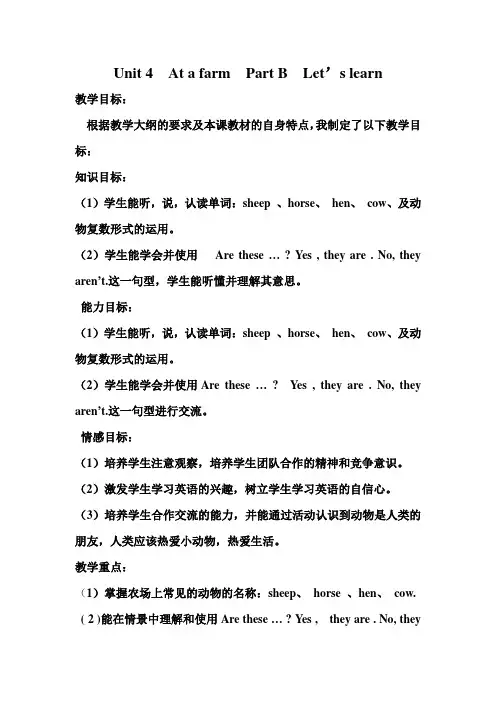
Unit 4 At a farm Part B Let’s learn教学目标:根据教学大纲的要求及本课教材的自身特点,我制定了以下教学目标:知识目标:(1)学生能听,说,认读单词:sheep 、horse、hen、cow、及动物复数形式的运用。
(2)学生能学会并使用Are these …? Yes , they are . No, they aren’t.这一句型,学生能听懂并理解其意思。
能力目标:(1)学生能听,说,认读单词:sheep 、horse、hen、cow、及动物复数形式的运用。
(2)学生能学会并使用Are these …? Yes , they are . No, they aren’t.这一句型进行交流。
情感目标:(1)培养学生注意观察,培养学生团队合作的精神和竞争意识。
(2)激发学生学习英语的兴趣,树立学生学习英语的自信心。
(3)培养学生合作交流的能力,并能通过活动认识到动物是人类的朋友,人类应该热爱小动物,热爱生活。
教学重点:(1)掌握农场上常见的动物的名称:sheep、horse 、hen、cow. ( 2 )能在情景中理解和使用Are these … ? Yes , they are . No, theyaren’t. 这一句型,学生能听懂并理解其意思。
教学难点:掌握动物的名称及复数的表达方式。
教学准备:自制两棵大树图片,若干苹果图片,课件。
教学过程:一、Warm-up1.欣赏歌曲:《Old Macdonald’s》2.Free talk:T: Hello, boys and girls, Do you like animals? What animal do you like? Mr Macdonald has a big farm , There are many animals on it , Let’s go and have look !二、Presentation1. 讲清本课的活动规则,黑板上贴两棵树,一棵树属于男孩子,另一棵属于女孩子,在本课的学习中,你只有准确清晰的回答出我的问题,你才能得到一个苹果,贴到属于你们团队的树上。
人教版小学四年级英语下unit 6 at a farm教案
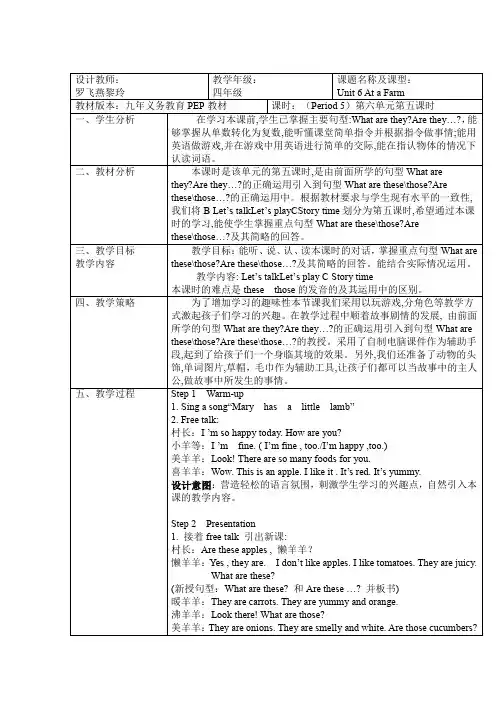
(新授句型:What are those ?和Are those …?并板书)
2. T:(指着身边的potatoes)Are these potatoes?
Ss: Yes, they are.
二、教材分析
本课时是该单元的第五课时,是由前面所学的句型What are they?Are they…?的正确运用引入到句型What are these\those?Are these\those…?的正确运用中。根据教材要求与学生现有水平的一致性,我们将B Let’s talkLet’s playCStory time划分为第五课时,希望通过本课时的学习,能使学生掌握重点句型What are these\those?Are these\those…?及其简略的回答。
五、教学过程
Step 1 Warm-up
1. Sing a song“Mary has a little lamb”
2. Free talk:
村长:I ’m so happy today. How are you?
小羊等:I ’m fine. ( I’m fine , too./I’m happy ,too.)
T:(指着远处的onions)Are those onions?
Ss: Yes, they are.
举多几个例子让学生区分these和those的区别。
3. Listen to the tape and read after it,then read in groups.
设计意图:此环节根据学生的年龄特点,利用多媒体课件呈现故事,使学生通过课件里的图片、动画、以及课件里的语言理解故事的内容。故事教学是本节课的重点,故事中的主要句型是学生学习的重点,学生听懂了故事也就听懂了主要句型。
最新小学英语四年级下册《Unit6 At A Farm》教案
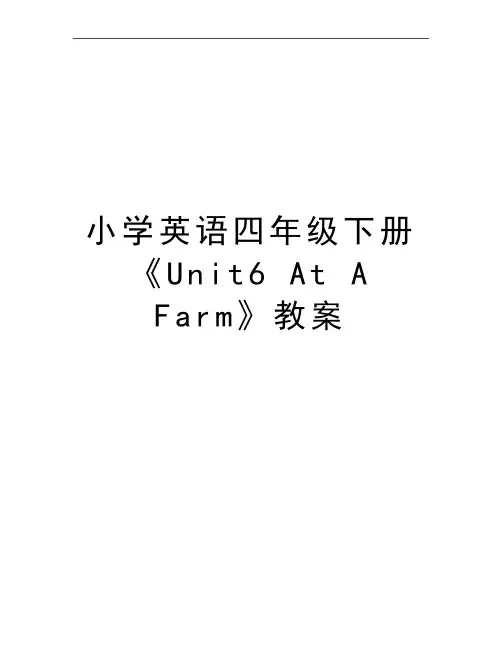
小学英语四年级下册《U n i t6A t AF a r m》教案PEP小学英语四年级下册《Unit6 At A Farm》教案A Let’s Talk教学目标:知识目标:1)能熟练使用重点句型:Are they …? No, they aren’t. They are…2)能认读单词:donkey及donkeys.3)80%的同学能正确地读出对话。
情感目标:1)培养学生的小组合作意识。
2)多了解一些关于农场的知识。
学情分析:1)通过上一课时的学习学生已基本掌握一些农场上动物的单复数形式。
为本课时重点句型:Are they …? No, they aren’t. They are…学习做了铺垫。
How many…do you have?的句型学生们在四年级上册已经学习过,所以只需简单复习一下。
教学过程:一、warm-up1)Greeting.2)T: In this class , we will visit Uncle Bill’s Farm together. But beforewe go to his farm. We should pass some tests. Test 1. Find themissing animals. 教师带领学生做what are missing?的游戏,既复习了单词又增加了趣味性。
在做what are missing?的环节时,强调名词复数的特点,并请学生特别关注sheep的复数形式。
3)Test 2 Sharp eyes: 复习句型How many… can you see?,降低了文中“How many cows do you have?的句型,在此游戏中教师可以穿插问2个学生,How many books do you have? How many pencils do you have?的问题。
二、Presentation1). 通过做Test3:听音判断的游戏,导入新句型:Are they …?No, they aren’t. They are…在问题中解决生词:donkeys.利用monkey-donkey monkeys-donkeys 2)通过做Test4: 边拍手边互相问答:Are they …?No, they aren’t.They are…来操练新句型。
小学英语PEP人教版四年级下册《Unit6 At a farm B Let's talk》教案5

小学英语PEP人教版四年级下册《Unit6 At a farm B Let’s talk》教案5一. 教材分析《PEP人教版四年级下册》Unit 6主要围绕农场展开,让学生学习与农场相关的词汇和句子。
本节课为B部分Let’s talk,通过一个关于农场的小故事,让学生学习新的单词和句型,并能够运用所学进行简单的交流。
二. 学情分析四年级的学生已经掌握了基本的英语语法和词汇,具备了一定的听说读写能力。
他们对新鲜事物充满好奇,善于模仿和创造。
在学习了Unit 6的前两部分内容后,学生已经掌握了部分与农场相关的词汇,对于本节课的学习会有很大的帮助。
三. 教学目标1.知识目标:学生能够听懂、会说、会读本节课所学的单词和句子,能够运用所学进行简单的交流。
2.能力目标:通过小组合作、互动交流,提高学生的口语表达能力和团队协作能力。
3.情感目标:培养学生热爱生活,关注自然,珍惜粮食的品质。
四. 教学重难点1.重点:学生能够听懂、会说、会读本节课所学的单词和句子。
2.难点:学生能够运用所学进行简单的交流,并在实际情境中正确运用。
五. 教学方法采用情境教学法、互动教学法和小组合作教学法,通过创设情境、学生互动、小组讨论等方式,激发学生的学习兴趣,提高学生的参与度和积极性。
六. 教学准备1.教师准备:准备好课件、单词卡片、农场图片等教学材料。
2.学生准备:预习本节课的内容,熟记单词和句子。
七. 教学过程1.导入(5分钟)教师通过提问方式引导学生回顾Unit 6前两部分的内容,复习与农场相关的词汇,为新课的学习做好铺垫。
2.呈现(5分钟)教师通过课件展示本节课所学的单词和句子,让学生初步感知和理解。
3.操练(10分钟)教师引导学生进行单词和句子的认读练习,可以通过游戏、竞赛等形式进行,提高学生的学习兴趣。
4.巩固(5分钟)教师创设情境,让学生分角色扮演,用所学单词和句子进行对话,巩固所学知识。
5.拓展(5分钟)教师引导学生运用所学知识进行小组讨论,讨论自己在农场的情景,提高学生的实际运用能力。
小学英语PEP人教版四年级下册《Unit6Atafarm》教学设计6
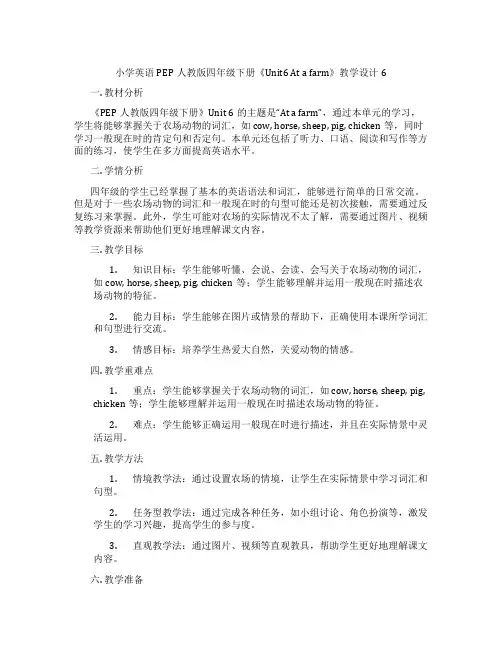
小学英语PEP人教版四年级下册《Unit6 At a farm》教学设计6一. 教材分析《PEP人教版四年级下册》Unit 6的主题是“At a farm”,通过本单元的学习,学生将能够掌握关于农场动物的词汇,如cow, horse, sheep, pig, chicken等,同时学习一般现在时的肯定句和否定句。
本单元还包括了听力、口语、阅读和写作等方面的练习,使学生在多方面提高英语水平。
二. 学情分析四年级的学生已经掌握了基本的英语语法和词汇,能够进行简单的日常交流。
但是对于一些农场动物的词汇和一般现在时的句型可能还是初次接触,需要通过反复练习来掌握。
此外,学生可能对农场的实际情况不太了解,需要通过图片、视频等教学资源来帮助他们更好地理解课文内容。
三. 教学目标1.知识目标:学生能够听懂、会说、会读、会写关于农场动物的词汇,如cow, horse, sheep, pig, chicken等;学生能够理解并运用一般现在时描述农场动物的特征。
2.能力目标:学生能够在图片或情景的帮助下,正确使用本课所学词汇和句型进行交流。
3.情感目标:培养学生热爱大自然,关爱动物的情感。
四. 教学重难点1.重点:学生能够掌握关于农场动物的词汇,如cow, horse, sheep, pig,chicken等;学生能够理解并运用一般现在时描述农场动物的特征。
2.难点:学生能够正确运用一般现在时进行描述,并且在实际情景中灵活运用。
五. 教学方法1.情境教学法:通过设置农场的情境,让学生在实际情景中学习词汇和句型。
2.任务型教学法:通过完成各种任务,如小组讨论、角色扮演等,激发学生的学习兴趣,提高学生的参与度。
3.直观教学法:通过图片、视频等直观教具,帮助学生更好地理解课文内容。
六. 教学准备1.教学课件:包括农场图片、动物词汇卡片、视频等。
2.教学资源:农场动物的图片、视频等。
3.练习题:包括听力、口语、阅读和写作等方面的练习。
PEP小学英语四年级下册《Unit 6 At a Farm》精品教案
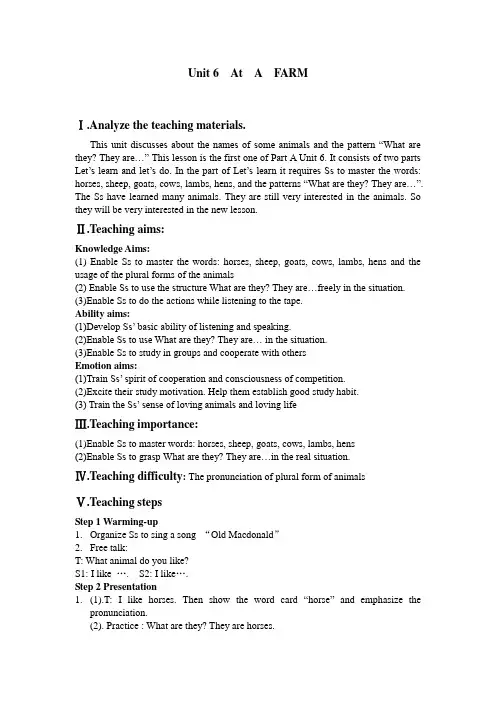
Unit 6 At A FARMⅠ.Analyze the teaching materials.This unit discusses about the names of some animals and the pattern “What are they? They are…” This lesson is the first one of Part A Unit 6. It consists of two parts Let’s learn and let’s do. In the part of Let’s learn it requires Ss to master the words: horses, sheep, goats, cows, lambs, hens, and the patterns “What are they? They are…”. The Ss have learned many animals. They are still very interested in the animals. So they will be very interested in the new lesson.Ⅱ.Teaching aims:Knowledge Aims:(1) Enable Ss to master the words: horses, sheep, goats, cows, lambs, hens and the usage of the plural forms of the animals(2) Enable Ss to use the structure What are they? They are…freely in the situation.(3)Enable Ss to do the actions while listening to the tape.Ability aims:(1)Develop Ss’ basic ability of listening and speaking.(2)Enable Ss to use What are they? They are… in the situation.(3)Enable Ss to study in groups and cooperate with othersEmotion aims:(1)Train Ss’ spirit of cooperation and consciousness of competition.(2)Excite their study motivation. Help them establish good study habit.(3) Train the Ss’ sense of loving animals and loving lifeⅢ.Teaching importance:(1)Enable Ss to master words: horses, sheep, goats, cows, lambs, hens(2)Enable Ss to grasp What are they? They are…in the real situation.Ⅳ.Teaching difficulty: The pronunciation of plural form of animalsⅤ.Teaching stepsStep 1 Warming-upanize Ss to sing a song “Old Macdonald”2.Free talk:T: What animal do you like?S1: I like …. S2: I like….Step 2 Presentation1.(1).T: I like horses. Then show the word card “horse”and emphasize thepronunciation.(2). Practice : What are they? They are horses.(3). T: I like horses very much and I can ride a horse. (show the CAI)Ss following T doing and saying.2.(1). T: Do you like horses?Ss: Yes, I do.T: Me too, I also like cows. Show the card and emphasize the pronunciation.(2). Practice: What are they? They are cows.(3). T: (Point to the card) Are they strong?Ss: Yes, they are.T: They can produce milk, now. Let’s milk a cow. (show the CAI)Ss following T doing and saying.3.(1). T: (show the CAI) Listen! Are they cows?Ss: No, they aren’t.T: What are they? (Show the CAI)Ss: They are chicks.T: Yes, they are hungry and they are seeking their mother. Look, this is their mother. It’s a hen. (show the card)(2). Practice : What are they? They are hens.(3). The hens are hungry too. Let’s feed the hens. (show the CAI)Ss do following the teacher.4. (1). Show a card of the coat and ask: What is it?Ss: It is a coat.Show a new word “goat” and let Ss try to read it then show the new word card.(2). Practice: What are they? They are goats.(3). T: The goats like jumping. Let’s sing and dance with the goats. (show the CAI) Ss following T doing and saying.5. (1) Covering a part of the picture and ask : Is it a goat/ cow…?Ss: No, it isn’t.T: show the picture and say: It is a lamb. Here, the letter “b” is silent.(2). Practice : What are they? They are lambs.(3).T: Do you like lambs?S: Yes, I do.T: Why?S: It’s cute.T: Yeah, Let’s hold a lamb.(show the CAI)Ss do following the teacher.6. (1). The lamb is a baby, when it grows and grows, it turns to be a sheep.(show the picture)(2). Practice : What are they? They are sheep. Emphasize the plural form of“sheep”.(3) T: What color are the sheep?Ss: They are white.T: Its fleeces are white and long. Let’s shear a sheep.(show the CAI)Ss do following the teacher.Step 3 Consolidation1. Listen and read unit 6 At a farm Part A2. A game: what aminals are missing? (show the CAI)Step 4 Practice1.Show the CAI and ask: what is it? What are they?Ss: It is a…. They are ….Chant : What is it? What is it? It is a…. It is a ….What are they? What are they? They are…. They are….2.Ask some Ss to practice.3.Show the CAI and let the Ss practice in pairs.4.CheckStep 5 Homework(1) Listen and read Unit 6 At a farm Part A(2)Write the names of animals。
pep四年级下册unit6atafarm教案
pep四年级下册unit 6at a farm教案精品文档PEP四年级下册Unit 6At a Farm教案题目:PEP四年级下册Unit6AtaFarm教案 Unit6第一课时一、教学内容与目标1(教学内容:’slearnLet’sdo2(教学目标:a(能够听、说、认读单词:sheep,hen,cow,horse,goat,lamb,PEP四年级下册Unit6AtaFarm教案。
b(了解单词sheep,hen,cow,horse,goat,lamb的复数形式。
c(听懂Letsdo部分是指示语,并按要求做出相应动作。
二、教学重难点分析1(重点:单词sheep,hen,cow,horse,goat,lamb及其复数形式的表达;句型whatarethey,和Arethey…?的问答。
2(难点:horse,sheep,goat的复数形式表达。
三、课前准备1(Let’slearn(A)部分挂图,录音。
2(教师和学生共同准备所学动物单词卡。
(单、复数各一套)3(Let’sdo部分课文录音。
四、教学步骤(一)导入:1、教师提问:,whatanimalsdoyouknow?2、学生说说自己知道的动物单词,一旦学生说出本课涉及到的单词,教师要及时拿出卡片,请这位同学来教大家读。
(二)呈现新知:1、教师说:Doyouknowafarm,’sgoandhavealook教师出示Let’slearn(A)部分挂图,说:Look,?2、学生听懂后,教师可先试着让学生指图回答,能说出英文的学生给与表扬,也可让学生用中文回答。
3、告诉学生我们要学习有关farm的内容,教读farm。
4、让学生听录音两次并跟读。
5、教师出示单词1 / 15精品文档卡:sheep,hen,cow,horse,goat,lamb,让学生进行认读,将一些发音规律,帮助学生记忆单词。
如:ee在sheep中发[i:]ow在cow中发[aU],oa在goat 中发[EU]等等,也可以启发学生说说怎样记住每个单词。
人教版四年级下册英语Unit6《AtaFarm》教案
人教版四年级下册英语Unit6《AtaFarm》教案《At a Farm》教案(一)教学目标1、能够掌握本单元四会单词及句子These are…… Those are……的默写。
2、能够看图读懂、理解文章的大意,掌握一定的阅读技巧,提升阅读能力。
3、能够独立完成简单的英语句子输出,学会写话。
4、能动手设计自己的农场。
5、学会懂得多吃蔬菜与水果。
6、有热爱动物,保护大自然意识。
教学重难点重点:四会内容的掌握难点:阅读技巧的提升和英语的输出运用及these those的区别。
教学工具单词卡,相关课件,农场设计卡,画笔等。
教学过程(一)师生活动Let’s chant(Preparation准备活动)Ilike tomatoes.Ilike potatoes.CarrotsI will try.Ilove to eat green beans.Butonions makes me cry.(二)新课呈现Let’s learn the new words1.教师出示单词卡,学生进行问答练习,学习单词,并板书。
Whatvegetables can you see in the chant?I cansee……(tomato, potato, carrot, green bean,hen,sheep ,cow, horse)2.单词复数。
tomatoes, potatoes, carrots, green beans,hens, sheep , cows, horses3.名词单数、复数的学习,强调tomato---tomatoes sheep---sheep4.提问学生,学习句型:What do you love to eat?I love to eat……(tomatoes, potatoes, carrots, green beans)Read and write1.学生听录音熟悉课文。
2.教师领读。
3.学生大声读课文。
小学英语PEP人教版四年级下册《Unit6Atafarm》word版教案
小学英语PEP人教版四年级下册《Unit6Atafarm》word版教案【课题】Unit 6 At a farm (第一课时)【教学目标】1、本节课学习的主要句型:Are they…? Yes, they are. / No. they aren’t.的意义。
2、能用正确的语音语调朗读本课的主要句型。
3、能形成单复数的概念,并能根据单复数的概念进行实际运用。
【教学方法】音乐教学、游戏教学。
【教学重点】单词:sheep, hen, cow, horse, goat, lamb 及其附属形式的表达。
句型:What are they? They are…以及Are they …? Yes, they are. / No, they aren’t.【教学难点】单词单复数及其特殊形式。
【教学准备】自制课件、单词帽子、Old MacDonald的歌曲及歌词、课文的录音。
【教学过程】一、Greetings:T: Good morning, boys and girls.S: Good morning, Miss Chen.T: Nice to meet you.S: Nice to meet you, too.T: How are you today?S: I’m fine, thank you, and you?T: I’m fine too, thank you.(教师下讲台随即挑选几位同学进行回答)二、新课导入:T:T oday I bring you something special, look! Who’s that?S: … (Old MacDonald)T: Great! As we know, he has a big farm. What’s on his farm? Now, let’s sing a song and you’ll get the answer. (If you can sing it, just sing together.) (教师板书课题:Unit 6 At a farm)T:Old MacDonald’s farm is very big. On his farm, he has many animals. What animals are they? Look!S: duck …T: look and guess. (看一看,看看农场上还有什么动物?)三、新单词的学习:1、出示图片(被遮住大部分,只露出马尾部分):T: Now, guess! What’s this?S: …(PPT出示单词:horse )依次步骤揭示cow, sheep, hen, lamb, goat 。
2017人教PEP英语四年级下册Unit6 At a farm优质教案
Unit 6 At a Farm ( 第三、四课时)教案教学目标:1、复习本册的所有字母组合的发音。
2、能听、说、读、写本册的四会单词。
教具准备:教学光盘、单词卡片。
教学重点:能听、说、读、写本册的四会单词。
教学难点:正确书写本册的四会单词。
教学过程:一、复习引题1、师生做日常口语练习:A: Can I help you?B: Yes...A: Are they OK?B: ...2、请学生表演A部分Let’s talk的对话。
二、教学新课1、播放Read aloud的录音,让学生听歌谣。
2、让学生跟着动画学说歌谣,同时可用手打节奏。
3、播放Listen and chant的录音,让学生划出含有字母组合的单词。
三、巩固练习1、完成作业本上的配套练习。
四、布置作业1、抄本册四会单词4+1模式五、板书设计六、教学反思第四课时教学目标:1、听懂会说:“Can I help you? How much is this skirt? It's very pretty. That's expensive. It's too expensive.”2、能在实际的情景中运用进行实际交际。
3、培养孩子购物要节约的观念。
教具准备:教学光盘、单词卡片。
教学重点:句型:Can I help you? How much is this skirt? It's very pretty. That's expensive. It's too expensive.教学难点:对新词的读音的指导和规范,如:“eighty-nine yuan.”教学过程:一、复习引题1、日常口语训练。
2、用算术题复习数字,为价格的描述作好准备。
二、教学新课1、教师通过课件展示各种衣物。
2、教师和孩子们进行对话的交流T: Look at this shirt .It’s colourful.S: Yes, it’s pretty.T: How much is it?S (请一个孩子走到背面翻出价格)It’s one hundred yuan . It’s too expensive.3、教师播放课件,让孩子观看故事,理解内容。
- 1、下载文档前请自行甄别文档内容的完整性,平台不提供额外的编辑、内容补充、找答案等附加服务。
- 2、"仅部分预览"的文档,不可在线预览部分如存在完整性等问题,可反馈申请退款(可完整预览的文档不适用该条件!)。
- 3、如文档侵犯您的权益,请联系客服反馈,我们会尽快为您处理(人工客服工作时间:9:00-18:30)。
PEP四下Unit 6 At a Farm
Part B Let’s learn
双桥小学徐舒
一、教学目标
1. 能力目标
(1)能够说出自己喜欢的蔬菜: I like tomatoes/ potatoes/carrots...
(2)能简单描述出所学蔬菜的特点,如:The potatoes are big and tasty. The cucumbers are tender and green.
2.知识目标
(1)复习学过的颜色: red, yellow , pink, green, brown, orange, purple, white…
(2)学习蔬菜词汇及其复数形式:potato(es), tomato(es), onion(s), cucumber(s), carrot(es). 3.情感、文化等目标
培养学生多食蔬菜的意识, 让他们明白新鲜的蔬菜是健康食品,应该多吃。
二、教学重、难点
1.三会(听说读)单词:potato, tomato, onion, cucumber, carrot.
2.单词potato , tomato的复数形式。
3.理解并会说chant中描述蔬菜特点的形容词:juicy, tasty, tender, yummy,smelly.
三.课前准备
1.准备多媒体课件。
2.准备所学的新鲜蔬菜、煮熟并切碎。
3.准备制作蔬菜沙拉的各种工具。
四.教学过程
1.热身&复习:
(1) Greetings: What’s the weather like today?
What are they?What colour are they?
What’s this?What colour is it?
Do you like apples?What do you like?
I like dogs.What do you like?
(2)Let’s chant:Look at the cat. It is fat .
Look at the pig. It is big.
Look at the monkey. It is funny .
Look at the mouse. In my house. Ahhh!!!
2.呈现&操练
(1)教学carrot
a. 引出:在chant的最后,出现a rabbit
T: Look at the rabbit. It is cute. T 扮演兔子:Hello!Boys and girls. Do you know what do I like ?由此引出carrot
b.教学carrot的发音。
a carrot----carrots
c. T:What colour are the carrots? Do you like carrots?
Ss: They are or ange. Yes,I like carrots. / No, I don’t like carrots.
T: I like carrots. They are yummy and orange.。
d. Guess: How manycarrots? 教师拿出事先准备好的放在袋子里的carrots,问:How many
carrots? 让学生猜一猜,再数一数
(2) 教学cucumber
a. 引出:紧接上一个环节中,最后一次出示的袋子里装着carrots和a cucumber.
b. 分解cucumber的读音,cu-cum-ber,注意两个u的不同发音。
c. 快速闪现,Guess: How many cucumbers?
d. What colour are they? Ss : The cucumbers are _________.
e. Taste and say: I like cucumbers . Tender and green(折断一根嫩黄瓜,展示黄瓜的嫩脆,咔嚓咔嚓cucumber,咔嚓咔嚓tender)
(3) 教学tomato
T:I’m thirsty.Can I have some juice?老师拿出课前准备好的番茄汁,品尝一下:Oh,yummy!Can you guess what kind of juice it is?Apple juice?Orange juice? No,it’s the tomato juice!
a、课件出示单词juice(果汁),把末尾的字母替换成y,巧妙地引出新授单词juicy(多汁的)。
T:The tomatoes are juicy.What colour are they?
Ss:They are red.
b、a tomato------tomatoes
Spell tomato
(4) 教学potato
a. 引出替换tomato中的辅音字母得到potato
b. a potato ----potatoes What colour are the potatoes?
c. T: Do you like potatoes? Do you like French fries?They are made from potatoes. (CAI) Help Ss to say:I like potatoes . Tasty and brown.
(5)教学onion
a. 引出:谜语——洋葱
b.教学onion , What colour are they?Purple onions ,white onions
c.T: Do you like onions? I don't like onions. They are smelly.(做很难闻状)
d. Ss smell and say The onions are smelly.
(6)Let’s chant.
跟录音读,学生边打拍子边说。
3.巩固& 拓展
(1)活动:蔬菜沙拉(课件出示蔬菜沙拉图片,出示关键词和句子,让学生看着句子对话。
)a.师拿出好的蔬菜丁,问学生:What do you like? 让学生说出自己喜欢的蔬菜并能运用所学的形容词来进行简单的描述:I like tomatoes. They are juicy and red….. (说出一样分给一样。
最后给他们放上沙拉酱。
)
b.让学生自由交谈他们所喜欢的蔬菜。
(2)师小结:Vegetables and fruit are good for our health. Let’s eat them every day and keep fit!蔬菜和水果对我们的身体有益,让我们天天吃蔬菜和水果来保持身体健康吧!。
